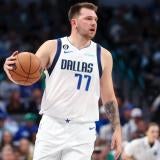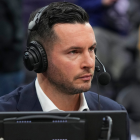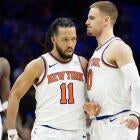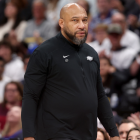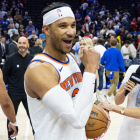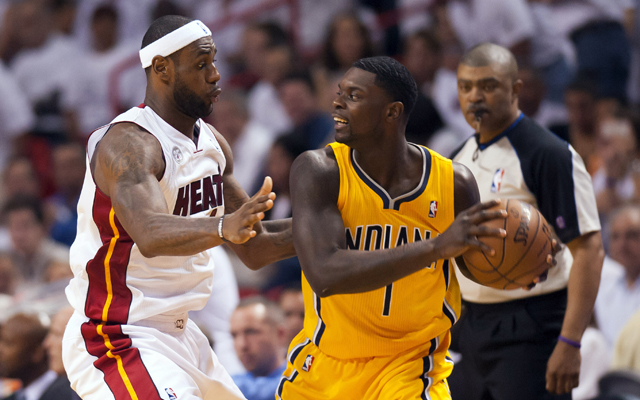
MIAMI -- The Indiana Pacers have a budding young star at the small forward position with Paul George. In just his third season, George had a trifecta of success with his first All-Star Game selection, the Most Improved Player award, and being named All-NBA Third Team. When you're facing the Pacers and want to keep George in check, you're almost always going to see the opposition's best perimeter defender guarding him.
In Game 1 against the Miami Heat, we saw one of the top defenders in the league, if not the top defender in the league, in LeBron James start out defending Lance Stephenson instead of George. Dwyane Wade and his balky knee took on the role of being the initial roadblock in whatever Paul George tried to do on offense. Stephenson has had some really nice moments during these playoffs, but to draw James on defense can be a bit head-scratching to some.
The reason James is defending Stephenson is because it allows him to defend everybody at once. Stephenson isn't exactly a deadeye outside shooter. For the season, he shot 33.0 percent from 3-point range and 28.1 percent from midrange. He gets the majority of his points off of moving toward the basket. If you play off of him, it makes it a lot harder for him to get the angles he needs with the ball to be successful.
With James not having to pay much attention to Stephenson on the perimeter, it allowed him to cheat defensively to help out inside or get into rebounding position so the Pacers didn't annihilate the Heat on the boards, and that's exactly what he did. James helped inside tremendously against Roy Hibbert and kept getting in the way of what the Pacers do well -- dominate the paint.
"Right now, that’s the look we like," Heat coach Erik Spoelstra said after his team's practice on Thursday, "but we know as the series goes on you have to continue to make changes."
It seems like the Pacers may be the ones who have to find a way to make changes in order to keep James honest on defense and not allow him to cheat toward the paint as much.
Four minutes into the game, the Pacers ran a great high-low play with David West and Hibbert to get their center a shot at the basket. Hibbert flashed to the top to receive a pass from West, but then slipped past his defender and dived back toward the basket. West delivered a perfect bounce pass.
However, the basket never happened because James had no problem leaving Stephenson in the corner to shoot an open 3-pointer if he got the ball. Hibbert went for the shot inside and James smacked it away. It eventually led to a Pacers' turnover when James swiped the ball off of Hibbert's leg following the Pacers' center recovering the blocked shot.
Throughout the game we saw plenty of instances in which James cheated far toward the basket and ignored Stephenson on the perimeter.
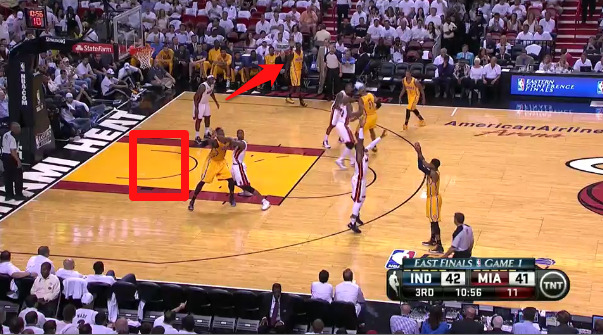
If the Pacers were trying to post Hibbert up against the smaller defender, James was lurking from the weak side, uninhibited by his defensive assignment's open space on the perimeter.
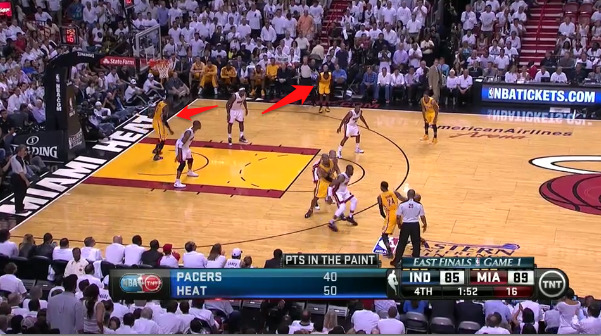
If the Pacers were running a pick-and-roll with Hibbert circling under and around the basket as a dump-off option, James was stalking his move and looking to cut off George or West if they ended up with the ball in the middle of the paint.
There has to be a better way to occupy James on defense, instead of letting him play free safety in the middle of the half court. But what is the solution? Does Stephenson have to make shots and force his defender to hesitate before helping inside? He was 0 of 5 from 3-point range in Game 1.
"I guess if Lance makes shots, you got to keep him honest," Hibbert said at practice on Thursday. "But it is what it is. We have to figure out a way to win."
Is it simply Stephenson making shots or can there be other ways to thwart his defender's advances toward the big men inside?
"Part of it is hitting shots," Pacers coach Frank Vogel said, "but he’s got to be active with cuts and crashes and his open court attack. He’s got to make sure he puts pressure on LeBron to guard him."
The big key to how Indiana can solve James roaming on defense is Stephenson being active enough to occupy whatever space LeBron divorces due to paying defensive attention elsewhere. As we saw in Game 1 against the New York Knicks, Stephenson is capable of being active and getting his points inside. But he didn't really do that in Game 1 against the Heat, and his inactivity helped hurt his team's attack at times.
Stephenson has been great at crashing the boards throughout the playoffs, but he can't really afford to do that on offense as much as the Pacers would normally like him to. If they crash the offensive boards with two or three guys and don't grab the ball, it can lead to quick points by the Heat, which is something Vogel is trying to avoid.
"We’d rather him get back in this series," Vogel said. "When one of our bigs is at the top of the key, that’s when we’ll allow and encourage the wings to crash."
As Spoelstra said, changes with matchups in this series will happen throughout. James is going to end up guarding just about everybody in a Pacers uniform at some time because his versatility and ability allows that to happen.
"LeBron already knows one through five, period," Spoelstra explained. "He’ll be guarding every single one of those guys like he did last night at some point during the game and that’s just the way it is."
But when he's guarding someone like Stephenson, he's really guarding everybody at one time. The Pacers have to find a way to keep him honest, which will help their big men continue to thrive in the paint.










